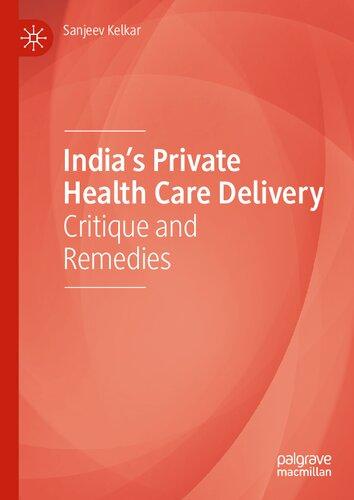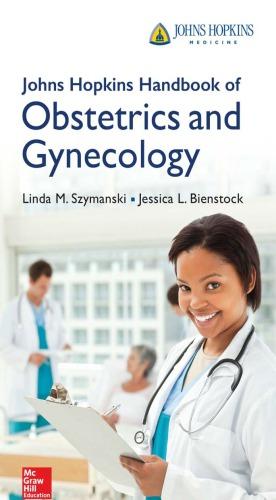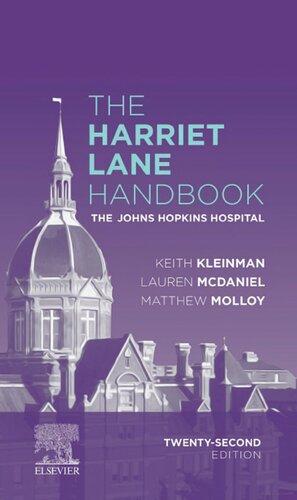Chester Chambers Visit to download the full and correct content document: https://ebookmass.com/product/improving-processes-for-health-care-delivery-lessons -from-johns-hopkins-medicine-1st-ed-2022-edition-edition-chester-chambers/
More products digital (pdf, epub, mobi) instant download maybe you interests ...
The Harriet Lane Handbook: The Johns Hopkins Hospital (Mobile Medicine) 22nd Edition The Johns Hopkins Hospital
https://ebookmass.com/product/the-harriet-lane-handbook-thejohns-hopkins-hospital-mobile-medicine-22nd-edition-the-johnshopkins-hospital/
India's Public Health Care Delivery: Policies for Universal Health Care 1st Edition Sanjeev Kelkar
https://ebookmass.com/product/indias-public-health-care-deliverypolicies-for-universal-health-care-1st-edition-sanjeev-kelkar/
Health and Health Care Delivery in Canada Third Edition
Valerie D. Thompson
https://ebookmass.com/product/health-and-health-care-delivery-incanada-third-edition-valerie-d-thompson/
India’s Private Health Care Delivery: Critique and Remedies 1st ed. 2021 Edition Sanjeev Kelkar
https://ebookmass.com/product/indias-private-health-caredelivery-critique-and-remedies-1st-ed-2021-edition-sanjeevkelkar/
The Harriet Lane Handbook-The Johns Hopkins Hospital, 23e (May 15, 2023)_(0323876986)_(Elsevier) Johns Hopkins Hospital
https://ebookmass.com/product/the-harriet-lane-handbook-thejohns-hopkins-hospital-23e-may-15-2023_0323876986_elsevier-johnshopkins-hospital/
Johns Hopkins Handbook Of Obstetrics And Gynecology 1st Edition Linda M. Szymanski
https://ebookmass.com/product/johns-hopkins-handbook-ofobstetrics-and-gynecology-1st-edition-linda-m-szymanski/
Decentring Health and Care Networks: Reshaping the Organization and Delivery of Healthcare 1st ed. Edition Mark Bevir
https://ebookmass.com/product/decentring-health-and-carenetworks-reshaping-the-organization-and-delivery-ofhealthcare-1st-ed-edition-mark-bevir/
The Harriet Lane Handbook 22nd Edition (2020) The Johns Hopkins Hospital
https://ebookmass.com/product/the-harriet-lane-handbook-22ndedition-2020-the-johns-hopkins-hospital/
Johns Hopkins Textbook of Cardiothoracic Surgery, Second Edition 2nd Edition – Ebook PDF Version
https://ebookmass.com/product/johns-hopkins-textbook-ofcardiothoracic-surgery-second-edition-2nd-edition-ebook-pdfversion/
Chester Chambers
Maqbool Dada
Kayode Williams
Improving Processes for Health Care Delivery Lessons from Johns Hopkins Medicine Improving Processes for Health Care Delivery Chester Chambers • Maqbool Dada Kayode Williams
Improving Processes for Health Care Delivery Lessons from Johns Hopkins Medicine Chester Chambers
Carey Business School
Johns Hopkins University
Baltimore, MD, USA
Kayode Williams
Anesthesiology & Critical Care Medicine
Johns Hopkins University, School of Medicine
Baltimore, MD, USA
Maqbool Dada
Carey Business School
Johns Hopkins Hospital
Baltimore, MD, USA
ISBN 978-3-031-19042-1 ISBN 978-3-031-19043-8 (eBook) https://doi.org/10.1007/978-3-031-19043-8
Mathematics Subject Classification (2020): 90B90, 90B22
© The Editor(s) (if applicable) and The Author(s), under exclusive license to Springer Nature Switzerland AG 2022
This work is subject to copyright. All rights are solely and exclusivelylicensed bythe Publisher, whether the whole or part of the material is concerned, specifically the rights of translation, reprinting, reuse of illustrations, recitation, broadcasting, reproduction on microfilms or in any other physical way, and transmission or information storage and retrieval, electronic adaptation, computer software,or bysimilar or dissimilar methodology now known or hereafter developed.
The use of general descriptive names, registered names, trademarks, service marks, etc. in this publication does not imply, even in the absence of a specific statement, that such names are exempt fromthe relevant protective laws and regulations and therefore free for general use.
The publisher, the authors, and the editors are safe to assume that the advice and information in this book are believed to be true and accurate at the date of publication. Neither the publisher nor the authors or the editors give a warranty, expressed or implied, with respect to the material contained herein or for any errors or omissions that may have been made. The publisher remains neutral with regard to jurisdictional claims in published maps and institutional affiliations.
This Springer imprint is published by the registered company Springer Nature Switzerland AG The registered company address is: Gewerbestrasse 11, 6330 Cham, Switzerland
IhavehadmanytalentsgiventomeandI feeltheyareintrust.Ishallnotburythembut givethemtotheladswholongforawider education.
Baltimore,MDJohnsHopkins
Foreword Qualitycomesnotfromtheinspection,butfromimprovementoftheproductionprocess.
WilliamE.Deming
Dr.’sChambers,DadaandWilliamscraftedatimelyandexcellentbodyofworkprovidingreal-timeexamplesfromalarge,highlymatrixedAcademicMedicalCenter ofJohnsHopkinsMedicine.Thoseofusbuffetedbythewindsofthecurrentpublic healthcrisisknowalltoowellthecollectivechallengeofcaringforourpatientsin healthsystemswithhighsteadystatebedutilization,emergencyroomwaittimes, clinicvisitsdelayedformonths,andoperatingandrecoveryroomholds.Ourcurrent statewaschallengedbythecrisisaswereconfguredcarelocationsandprovider networks,andcancelledelectiveprocedurestofreeupcapacity,equipment,and suppliestomeettheincreasedandunpredictablyfuctuatingloadofcriticallyillpatients.Withthisinmind,innovationinhospitaloperationalprocessestoimprove effcienciesofthesystem,whilemaintainingqualityandoutcome,wouldenhance equitableaccesstocareandbetterprepareforfuturepublichealthcrises.
JohnsHopkinsUniversityhasarichhistoryasthefrstintheUStohaveadepartmentofOperationsResearch.Theauthorsnotethefeldofoperationsmanagement leveragesworkfromindustrialengineering,economics,andoperationstoprovide insighttohowwethinkaboutasystemandmodelthefunctionsofhospitalmedical operations—ultimately,improvingeffciencyandoutcomes,reducinghealthcare wasteandimprovingaccess.
Theirworkprovidesexemplarsofhealthcarepracticesintheinpatientandoutpatientsettings.Ourhealthcaresystemsarecomplex,hencetheapplicationofsimplemethodstoanalyzeandinformwouldnotserve.Theybringtolightthenuancesofhealthcare,takingintoconsiderationthemyriad,uniquevariables:multi-
plecareproviders,varyinggeographicsanddiseaseprevalence,highlyspecialized providers,patientswiththecomplexityofchronicco-morbidities,multiplehandoffs,andmore.Allareinterrelatedandaffectthroughput,requiringoperationaleffcienciestooptimizeutilizationofsystemcapacities.Howdowepredicttheperformanceofthesecomplicatedsystems,patients,careproviders,sharedresources, changesinpayerandpractices,andunanticipatedstrainsonthesystem?Applicationsoftheauthors’describedfoundationalprinciplescanprovideinsighttoinform strategyandtacticsleadingtoimprovedeffcienciesandpredictabilityofperformance.
Asthefeldmovesforward,increasedapplicationofartifcialintelligencetools willengenderasharedfuturewhereonecouldimagineeveryhospital’soperational strategybasedonadigitaltwintoinformongoingdecisions(Eroletal(2020)). Thecreationofhospitaldigitaltwinscouldfacilitatetestingasystemundervarying permutationsofdesignandoperationstobetterpredictperformance.Buildingon theauthors’foundationalprinciples,alongwiththefurtherapplicationofartifcial intelligencetools,willallowmodelingofdatainthesecomplexsystems,tobetter positionhealthsystemstoallowforplanningandaccesstocareatbaselineandfor futurepublichealthcarecrises.
Gainesville,Florida,USA
August2022
ColeenKoch,MD,MS,MBA
FolkeH.PetersonDean’sDistinguishedProfessor Dean,UniversityofFloridaCollegeofMedicine
Preface Regardlessofcurrentbackground,position,ordemographiccharacteristics,atime willcomewhenyouwillbedeeplyconcernedaboutthefunctionofsystemsthat providehealthcareservices.Thepersonmostdirectlyinvolvedmaybeyou,butit maybeaparent,achild,afriend,orsomeotherlovedone.Nolifewillescapethe needforafunctioningsystemtodeliverhealthrelatedcare.Thus,millionsofhours havebeenspentdeveloping,managing,andworkingtoimprovethefunctioningof suchsystems.
Earlyeffortstodevelophealthcaresystemssurelybeganbeforerecordedhistory. Thedesiretoavoidormanagepainisinstinctivetoallsentientbeings.Theearliestwritingthatiscommonlylabeledasamedicaltextstemsfromsixpapyrifrom ancientEgyptanddatetobetween2000and1500BCE(Stiefeletal(1996),Castiglioni(2019)).Theseearliestrecordedeffortsincludetheuseofherbsandpractices thoughttobehelpfulbasedonseriesofrecordedobservations.Theeffectivenessof sucheffortswasamixedbag,butovertimehumansmademorediscoveriesabout howdifferentpractices,andingestionofvariouselementseasedpain,orprolonged life.
Muchlater,theenlightenmentandthedevelopmentofthescientifcmethod yieldedmoreformalwaystoexperiment,testmethods,andmeasureresultsineffortstoidentifybetterapproaches.(Bernard(1957))Theneedtoco-locatevaried resourcesandnewlydiscoveredelementsofcareeventuallyledtotheconsolidation ofsucheffortsandthecollectionofresourcesinlargerspacesthatbecameformal hospitalsandclinics.
Beginninginthe19thcenturyavariousareasofengineeringandappliedmath weredirectedtotheproblemofbuildingandmanagingthehospitalanditshoused
processes.TheneedtoimprovethesesystemswasaprimarydriverofthefrstAmericanuniversitiesthatfocusedonresearchinadditiontoteaching.OneoftheearliestleadersinthisregardswasasmallschoolinBaltimore,Marylandfoundedby JohnsHopkins(French(1946)).Thisearlymedicalschoolandassociatedcollectionofsmallerschoolswasaleaderinthecreationofmanypracticesstillused todayincludinggrandrounds,asystemofinternsandresidents,andtheformation ofspecialtiesthatfocusonasubsetofdiseasesorpatientssuchasneurosurgeryand pediatrics(Long(1991)).
Effortstomakethehospitalrunbetterandserveagrowingpopulationquickly includedexpertisefromfacultywithskillsinengineeringandmathematics.Consequently,JohnsHopkinsdevelopedthefrstdepartmentinanAmericanuniversityfocusedonwhateventuallybecomeknownasOperationsResearchin1952 (Flagle(2002)).ThetoolsdevelopedinOperationsResearchdepartmentsincluded suchesoterictopicsasQueueingtheory,DiscreteEventSimulation,andotherforms ofmathematicalmodelinginwhichanabstractrepresentationofanactualsystem couldbeconstructedandanalyzedaspartofthesearchforbetterwaystogetthings done(GassandAssad(2005)).Thus,thelinkbetweenhospitaloperationsandOperationsResearchwasinstitutionalizedintheUS.(SimilareffortstookplacesimultaneouslyintheUK.)
Theeconomicrealityofthecountryevolvedatthesametime.Intheearly1800’s barteringforserviceswascommonbecausethetypicalworkerhadverylimitedabilitytopayforhealthcaredelivery.Atthesametime,theskillsandeducationneeded todelivermedicalcaregrewrapidlyasscientifcapproachestocareproducedthousandsofnewideas,drugs,devices,andprocedures.Itquicklybecameverydiffcult andtimeconsumingforonetolearnallthatneededtobeunderstoodforthegeneral practiceofmedicine.Theneedformoredevices,equipment,space,andtraininginevitablyledtoincreasesinboththequalityofcareandthecosttodeliverit.
Socialresponsestoincreasingexpensesincludedtheriseofmanybenevolentsocieties,religiouscharities,insurancecompanies,andevengovernmentprogramsto helpindividualsmanagethecostoftheseessentialservices.Overtimethisindustry grewtobecomethelargestsinglesectorintheworld’slargesteconomyandthat growthshowsnosignofstoppingintheforeseeablefuture.(CMS(2020),Lorenzonietal(2014))Suchgrowthhasconsequencesnotimaginedinthe19thcentury.
Governmenteffortstodealwithhealthcarecostsincludeeverexpandingbodies ofregulationsandamyriadofwaystorestrictpaymentsthatarepresentedasefforts to“manage”costs.Theneedformeanstoimproveeffciencyandmanagecostsare readilyapparentfromconsiderationofafewsimplefacts.Forfullservicehospitals intheUnitedStates,themedianproftperpatientdischargeisnegative(-$82)(Bai andAnderson(2016)).Inotherwords,mosthospitalslosemoneyonthetypicaladmittedpatient.Administratorsstrugglenotjusttomaximizepatientsatisfaction,but tosimplykeepthedoorsopen.Mostruralareashaveashortageofcareproviders,
andalmosteveryhospitaladministratororclinicmanagerwillreportthattheshortagesofnurses(Lasateretal(2020))andgeneralpractitioners(Majeed(2017))show nosignofrelenting.
Thehighcostofinpatientcareleadstoincreaseddemandforoutpatientservices.Theshortageandgrowingcostsofprovidersforoutpatientservicesdrivesthe searchforincreasedthroughputfromfxedlevelsofresources.Consequently,the roleofengineersandmathematiciansthatwasfrstseenintheearlyconstruction ofmedicalfacilitiesemergesonceagaininaverydifferentcontext.Theengineers neededtodesignthebuildingsandspacesmustnowbesupplementedwiththose neededtoimprovetheprocessesthattakeplacewithinthosespaces.
Thismonographismeanttobeasmallcontributiontothebodyofknowledge directedtowardthisendeavor.Overthepastdecadetheauthorshaveworkedon dozensofqualityimprovementprojects,supervisedmanyeffortstogatherdataon systemperformanceandquality,taughtthousandsofstudentsfrombusinessand medicaldisciplines,andconstructedmanymodels,cases,researchpublications,and readingsonthiscriticaltopic.Allofthisworkhasbeencarriedoutwithintheenvironmentoftheworld’smostfamoushospital.
Wemakenoclaimstohavealloftheanswersoreventofullyunderstandallof themanynuancesoftheproblems.However,itdoesseemfairtosaythatthereader maybeaidedbyexposuretowhatwehavewitnessed,tested,andappliedinthis setting.
OrganizationofContent Ifwethinkaboutimprovingtheoperationsfunctionofasmalltomediumsized serviceunitwecaneasilyfndrecipesforthetaskasaseriesofsimplesteps.First, defnetheprocessesinplacetodelivertheserviceandanalyzethemintermsof resourceusage,capacity,quality,andoutput.Assumingthatpricingisexogenous totheunitmanager,(asisalmostalwaysthecaseinhealthcaredelivery)onethen focusesontheconnectionsbetweenthevaluedelivered,andthecostincurredtodeliverthatvalue.Oncethisunderstandingisinhandwecancomparetheperformance ofoneunittothatofanotheraspartofthemissiontoseekwaystoimproveoneor bothpartsofthisperformancemetric.
Unfortunately,whenweapplymanycommontoolsofthisapproachtotheprocessesofhealthcaredelivery,theyoftenbreakdown.Thisisnottosaythatthe inherentlogicofprocessanalysis,costreduction,andperformancemeasurement donotapplyinhealthcare.Rather,werepeatedlyfndthatspecialcareandadjustmentsareneededintheirapplication.Forexample,introductoryapproachesto processanalysistendtofocusontheidentifcationofabottleneckresource,and aparallelsearchforsourcesofvariabilitythatcanbeeliminated.Thisapproach facilitatesamatchingofcapacitytodemand,andincreasestheeffciencyandpre-
dictabilityofprocessperformance.However,severaldistinctivecharacteristicsof healthcareservicescomplicatethisapproach.Thesecharacteristicsincludepatient participation,simultaneity,perishability,intangibility,andheterogeneity(FitzsimmonsandFitzsimmons(2006)).
Tothislist,weaddtwoadditionalelementsthatwehavefoundtobequitecommon.First,manyresourcesaresharedamonganeverchangingcollectionofjobs. Resourcesfoatfromroomtoroom,orpatienttopatientwithfrequentinterruptions, repeatingsometasksandsplittingothersintosmallerpartsthatmustbeperformed bymultiplespecializedresources.Thehighdivisionoflaborinhospitalsandthe hierarchicalstructuresthatresultinterferewitheffortstodefne,measure,andcompareperformance.Therefore,improvingtheseprocessesrequiresadditionaltools andmodifedapproachesareneeded.
Second,thepsychologyandcultureofhealthcareprovidersissuchthatthinking ofcostreductionasafrstpriorityisanathematotheirnature.Fewprovidersholda clearideaofwhataprocesscostsbecausetheirmindswillnotallowthisconsiderationtobetheirprimaryconcern.Someproviderssimplyrefusetospeakinterms ofcosts,becausetodosofeelslikeitisimplicitlypricinghumansuffering.Onthe otherhand,administratorscannotescapetherealitythatmosthospitalslosemoney andthatifnoactionistaken,theywillceasetofunction.Costingisnotwidelyunderstoodinhealthcarebutthesystemwillcollapseifitisnotaddressed.
Thiscomplexityalsoaffectsthenotionsofqualityofserviceandvalueofoutcomes.Healthoutcomesforthemanymustbebalancedagainstattentiontothe relativefewwhoareonsiterightnowinwaysthateffecthealthoutcomes,costs, waitingtimes,andmanyotherelementsofpatientandproviderexperience.Thefact thatoutcomeslayalongsomanydimensionssimultaneouslymakessimplemetrics suchasproftandlosswoefullyinadequate.Again,thisisnottoimplythatsuch measurementsareimmaterial,butthattheirtreatmentmustbemanagedinastyle thatrespectsthecontextandcultureoftheindustry.
Afterwedodevelopanunderstandingofprocessperformance,quality,andcosts wecaneasilyidentifyasetofissuestobeaddressed.Withtheseissuesinmind, wewilladdressnewquestionsinthesecondphaseofthistext.Howarewegoing tomakethissystembetter?Canweidentifyanapproachthatcanbereplicatedand appliedacrosssystemswithsuchcomplexissuesandvaryingsettings?Itisclear thatmanagersneedtoolsthatarerobustenoughtobeusedinmanysettings,andyet powerfulenoughtohelpgetthisjobdone.
Thisshortbookisacompendiumofreadings,examples,exercises,andcasestudiesintendedtohelpidentifybothareasinneedofimprovement,andsomemeans tobringthatimprovementabout.InChapter1webeginwithaprimeronbasicelementsofProcessAnalysiswithaspecialefforttoplacetheterms,andapproaches withinthecontextofHealthCareManagement.Thereaderwillquicklyrealizethat
manycomplicatingfactorscommoninhealthcaresettingswarrantadditionaltools andadjustmentstothesegenericapproaches.Chapters2and3dealwithtoolsto helpinthisregard,andpresentexamplestoshowwhytheyareneeded.Morespecifically,Chapter2discussessimpletoolsincludingGanttChartsandtheCriticalPath Methodasaidstopresentingandunderstandingcomplexsystems.Chapter3considersissuesrelatedtosharedresourcesandschedulesthatcanberepeatedascycles throughoutasession,orshift.Chapter4introducesQueueingtheoryasawayto formalizetheconsiderationofvariabilityrelatedtointer-arrivalandactivitytimes. Chapter5wrestleswiththequestion“howmuchwillanepisodeofcarecost?” These5chaptersconstitutethefrstmajorsectionofthetext.
Withanunderstandingofthisfoundationalmaterialinhand,weturntothequestionofhowtomovefromanalysistoimprovement.InChapter6welayoutaframeworkthathasoftenhelpedusinthisregard.Asixstepprocessisdepictedtomove fromprocessmappingtoeventualprocessimprovement.Technicallyspeakingthe centerpieceofthismethodologyistheuseofDiscreteEventSimulationasamanagementtool.Consequently,Chapter7exploreswhythistoolisneeded,andwhat typesofinsightsitislikelytoproduce.Examplesofimplementationsandissuesuncoveredareinterspersedinthesechapterstohighlightapplicationsoftheapproach. WeconcludewithacollectionofcasestudiesasChapters8through11thatrelate tomajorportionsoftheprecedingchaptersandhelpcontextualizetheirapplication.
Readersareencouragedtoworkfromstarttofnish.However,eachchapteris writtenwiththeideathatmostpeoplewillpickandchoosewhatismostrelevantto thematanypointintime.Consequently,wehavemadeanefforttoalloweachchaptertoserveasastandalonereadingontherelevanttopic.Thisdesignresultsina bitofredundancy,buthopefullyreinforceskeymessageswithoutbecomingtedious.
BackgroundandIntendedAudience OverthepastdecadewehavetaughtcoursesonServicesManagement,Health CareServices,FundamentalsofHealthCareProcesses,IntroductionstoProcess Analysis,BusinessAnalytics,andahostofImmersioncoursesfocusedonvarious processesinthesettingsofclinics,hospitals,andinsurers.Inaddition,wehave publishedacollectionofworksinvariousmedicalandbusinessjournals,andhave beeninvolvedinahostofqualityimprovementprojects,businessplanningefforts, andoperationalstudies.Overthecourseofthisworkaguidingframeworkemerged thatcanbetaughtandrepeatedlyappliedinprocessimprovementefforts(Dadaand Chambers(2019)).Thisframeworkanditsassociatedreadings,cases,assignments, lectures,videos,andprojectsthatwedevelopedorledbecamethesourcecontent forthistext.
Theprimaryaudienceforthistextisstudentsincoursessimilartooursthatmay betaughtinschoolsofBusiness,Nursing,Medicine,andPublicHealthwithafocus onhealthcaredeliveryprocesses.Thefrsteightchapterseasilymapontoan8week
courseonthetopic.Wetypicallyuseoneormoreoftheincludedcasestudiesasan endofcourseprojectoraspartofafnalexam.Thesecasesftmostdirectlyinto MBA,orMSprogramsonthetopic.However,westrivetopresentthecontentina waythatmakesitaccessibletoundergraduatestudentsinadvancedelectivesaswell. Asecondaudienceincludesadministratorssuchasclinicmanagers,anddepartment headsworkinginthisspace.
Thesequencingofthechaptersisdesignedtoftwithinacoursestructure,but eachchapterstandsonitsownasareferenceforanyoneinneedofoneofthetools discussed.Whiletheworkpresentsavarietyoftoolswenotethatthebookisnot asubstituteformoredetailedtrainingmaterialonthemosttechnicaltopics.The primaryexampleistheuseofDiscreteEventSimulation.Manyothertextsfllthis void.Ourobjectiveistopresentthelogicoftheideasandtoexplaintheiruse.
Wesubmitthatanyreaderwhohaseverponderedquestionslike,“whyisthis placesoslow,”or“whyisthischargesohigh”willbeneftfromexposuretothis material.Westronglysuspectthatthisgroupincludesanyonewhohaseverinteractedwiththissystematastressfultime,whichisvirtuallyeveryone.Again,itsnot aquestionofifyouwilleverbeinthatgroup-onlyoneofwhen.
Finally,wewishtothankthehundredsofhealthcareprofessionalsinvolvedin ourpriorstudies,projects,andpublicationsthathaveledtothispoint.Thisincludes thetechnicians,nurses,doctors,administrators,andpatientswhoallowedustoview theiractivitiesandcare.Thanksalsogoestothedozensofreaders,reviewers,and presentationaudiencememberswhohaveaddedcontent,clarity,andfocus.
Mostimportantlywethankourfamilieswhohavesufferedlonghoursasreaders,supporters,andsoundingboardsalongtheway.ChesterChambersparticularly thanksS,L,andC:theQueenofAll,TheLightoftheWorld,andtheJoyousContinuationrespectively.
MaqboolDadaparticularlythankshiswifeShamimandourchildrenNatasha andMyrafortheirloveandsupportovermanydecadeswhiletoleratinginnumerablelong-windeddiscoursesonallthingsacademic.
KayodeWilliamsdedicatesthisworktohiswifeOyinkansolawithoutwhose loveandsupporthiscareerachievementswouldnotbepossible,theirsonsand daughter-in-law,OlatunjiandhiswifeVictoria,Oluwatomi,andtheirgranddaughter,Rosie,allofwhoseenquiringmindshavespurredhisquesttoacquireknowledge.
Baltimore,MD,USA
ChesterChambers July2022
MaqboolDada KayodeWilliams
Prologue Asweseektobuildintuitionregardingthemanagementofhealthcareprocesses, wemustwrestlewiththevastnessofthesystemunderstudy.Forexample,ifone looksintothebreadthofthesystemsconnectedwithJohnsHopkinsmedicineone fndsavastarrayofoutpatientclinicsandsurgicalcentersintheUSthathandle almostamillionpatientvisitsperyear,andhospitalsthathandleover4millionvisitsperyearincludingmorethan350,000emergencydepartmentvisits(Chambers andWilliams(2017b)).ThesystemalsoincludeshospitalmanagementandfacilitiesinChina,Singapore,India,Japan,UnitedArabEmirates,SaudiArabia,Turkey, Lebanon,Pakistan,Chile,Peru,Mexico,Brazil,Panama,Columbia,andCanada.In addition,thesystemaddsinsurancecompanies,andschoolsofmedicine,nursing, andpublichealth.
Intheconsiderationofsuchalargeandcomplexnetwork,itisimperativethatwe focusonlessonsandtoolsthatareapplicableacrossaplethoraofsettings.Withthis inmindwewillfocusonsmallerproblemsinproto-typicalsettingstohelpdevelop insightsthatcanbegeneralizedandadjustedtoftwhateversystemyouwishtoimprove.Itisinstructivetofocusonbitesizedchunksofacaredeliverysystemsuch asasingleclinic,emergencydepartment(ED),operatingroom(OR)suite,hospital ward,orhospital.Narrowingthefocusfacilitatescalculationsandallowsfortheexplorationofsmallexamplesthatcanbecreatedtoconveykeypoints.
Unfortunately,thisapproachfiesinthefaceofthefactthathealthcareisthe largestsingleindustryintheworld’slargesteconomy(forEconomicCo-operation andDevelopment(2020)).Asaresult,itinvolvesavastnetworkoffacilities,staff, physicians,andresourcesspreadacrossalmosteverycommunity.Thisvastlandscapecreatesamultitudeofhand-offsbetweenunits,andcoordinationamongfarfungagents.Anyanalysisofthesepartssuffersifconnectionstotherestofthe systemareignored.Thesimultaneousneedtobreaklargeproblemsintomanageableportionsandtounderstandthenatureofconnectionsamongsystempartsmakes thestudyofhealthcareprocessesuniquelydiffcultandcomplex.Withthisinmind, itishelpfultoenvisionavirtualsystemthatcanserveasamicrocosmofthelarger
reality.Wewillfrequentlyrefertothismentalmodelthroughoutthechaptersthat follow.
Envisionalargehospitallocatedinamoderatesizedcityontheeastcoastof theUnitedStates.LetusrefertothisunitasEasternUniversityHospital.Weuse thisconstructasaliterarydevice.Whilethebulkofourresearchandexperience hastakenplacewithintheJohnsHopkinssystem,Easternisnotintendedtobea replicationofanyparticularclinic,ward,unit,orhospital.Asaresult,theproblems presentedherearefullyinformedbyourstudyofactualsettings,butnotmeantto beduplicationsofanysingularunit.Thedatapresentedareacompositeofsources thatwehavegatheredoverthepast10years.
Easternhappenstobeateachinghospital,meaningthatmanyprocesseswillinvolveresidentsinadditiontothenurses,clinicalassistants,attendingphysicians, andahostoftechniciansandotherstaff.WewillconsiderpatientsenteringEastern throughatleast3routes.SomepatientswillarriveattheED.Wewillassumethat thesepatientsarriveoneatatimewithrandomtimesbetweenarrivals.Wewillalso assumethattheEDhassomefxednumberofexaminationrooms,butwewilltreat thewaitingareaasthoughithasinfnitecapacity.Mostpatientswhoenterviathe EDwilllaterbedischargedandsenthome.However,someportionofthesepatients willneedtomovetoanORsuite.TheORsuitewillhaveafxednumberofrooms. Mostsurgeriesinthissuitewillbescheduledinadvance(electivesurgeries)whereas thosethatstemfromEDvisitswillnot(emergencysurgeries).Afterpatientsleave theED,theymaytraveltoawardsuchasmedical,orthopedic,orneurologyward. Otherpatientswillbeincriticalconditionandwillbesenttoanintensivecareunit (ICU).TheICUwillhavefnitecapacityaswell.
MostpatientswhointeractwithEasternwilldosothroughtheEasternHospital OutpatientClinic(E-HOC).Thisclinicdealswithpatientsbyappointment,andhas scheduledopeningandclosingtimeseachworkingday.Thevastmajorityofpatients thatenterE-HOCwillgohomeaftertheirvisit.However,itispossiblethatthey willneedtomovetoanOR,ward,orveryrarelytheICU.ManagersatE-HOC andotherclinicsroutinelydealwiththeproblemofdeveloping,andfne-tuningan appointmentschedule.Thisscheduleisdesignedtostrikeabalancebetweenwaiting timesandovertimeoperationsfortheclinic.Anypatientsstillintheclinicatthe proposedclosingtimewillbeseen,meaningthattheclinicdoesnotreallyclose untilallofthepatientsontheschedulehavebeentreated.
0.1APatient’sJourneyThroughtheEasternUniversityHospital System FrankCaldwellresidesinthesamecityasEasternHospitalandisingenerally goodhealth.Frankdoesn’tthinkmuchaboutthehealthcaresystem,eventhough
0.1APatient’sJourneyThroughtheEasternUniversityHospitalSystemxvii
herecognizesitasthelargestsectoroftheeconomy,andthelargestemployerin histown.Frankhashealthinsurancethroughhisemployerbuthasn’tpaidmuch attentiontoitscostbecauseheisyoung,hedoesn’tusethesystemmuch,andhis co-paysareprettylow.OneafternoonFranksuffersaninjurytohisrighthandduring apickupbasketballgameafterworkanddecidestodrivehimselftotheED.Thisis hisentrypointtotheEasternHospitalSystem.
0.1.1EntryThroughtheED Frankhassufferedaninjurytohisrighthandduringthepickupbasketballgame, buthasalsohadsomepaininthishandbefore.Heisprettysurethatthisparticular injuryisjustasprain,buttheEDwasclosebyandhewantedtobesure.Either way,thisiscertainlynotalife-threateningcondition.1 AsheenterstheEDhesees alineof7patientswaitinginfrontofwhatlookslikeaNurses’station.Frankis prettysurethattherearemorethanoneofthesestationsbuttheothersarearound thecornersohedoesnotseeexactlyhowmanyareinplace.Whileheiswaiting henoticesthatpatientsarewalkingintotheEDataratethatheestimatestobe about1perminute.(actually55patientsperhour.)Duringashorttriagestepthat takesroughly4minutesheistoldthat,typically10%ofthepatientswhoenterthe EDareadmittedtothehospital.Therestarereleasedandgohome;usuallywitha prescriptionandsomeinstructionsabouthowtodealwiththemalady.Frankistold thatsincehisconditionisnotcriticalhewillhaveashortwaitbeforeseeingthe doctor.Heisalsotoldthatforpatientswhoareadmittedthetimewiththedoctor averagesabout30minutes,butforsimplercaseslikehisitislikelytobearound10 minutes.Frankwalksovertoawaitingareaandtakesaseat.Whenhelooksaround hecounts34patientsintheroomwithhim.Frankisconcernedthatthewaitwill beratherlong,butistoldthatmorethanonedoctorisintheEDthatday;andthat thestaffcanprocesspatientsquicklyenoughtomaintainafairlystablenumberof patientsinthewaitingroom.
FrankalsohappenstobeafairlynewstudentinaneveningMBAprogramin town,andrecallssomereadingsaboutprocessmanagement.Hewondersifhecan fgureoutafewthingsabouthowthissystemisworking.Likemostpatientshe isprimarilyworriedabouthishealth,butsincehehasafewminutestothink,he wondersifhecandeterminehowlongtheaveragepatientspendsintheED,how manydoctorsareworkingintheEDthatday,andhowmanypatientsareintheED intotal.
1 ThisvignetteparallelsaproblempresentedinAnupindietal(1999)andwillalsoberevisitedin thereviewmaterialafterChapter1.
0.1.2SpecialtyOutpatientClinic ItturnsoutthatFrankhasnotbrokenanybones.However,thedoctorrecommends thatFrankvisitDr.Twofer,whoisaspecialistinsportsmedicine.Thisparticular specialistisrenownforhisuseofarthroscopicprocedurestoremovefoatingbodies inwristandhandjointsandtheEDphysiciansuspectsthatthisissueiscontributing toFrank’sproblems.However,beforetheprocedurecanbescheduledFrankwill haveavisittoaclinicthatthissurgeonshareswithseveralotherphysiciansinthe Orthopedicsdepartmenttodeterminewhetherthesurgeryisreallynecessary.Upon arrivalattheclinic,Frankchecksinandisinformedthat,sincethisclinicisaffliatedwithateachinghospitalhewillbeseenbyaresidentfrst,beforeseeingDr. Twofer.FrankseesDr.Twoferchattingonthephoneinthehallwayandwonders whyhehastowait.Heistoldthatthedoctorisonthephonegettinginformationon anothercase,andthatFrankshouldnothavetowaitlongbecausetheresidentand theattendingphysicianwillworkinparallel,atfrst,andthencomebacktogether tocompleteFrank’svisit.
WhenFrankmadethisappointmentseveralslotswereavailable.Frankselected thefrstappointmentforthedayhopingthatthiswouldminimizehiswaitingtime. Hewassurprisedtofndthatanotherpatienthadthesameappointmenttimethathe did,buttheclinicalassistant(CA)atthedeskinformedFrankthatthiswasanormal practiceforthisclinic.WhilestandingatthedeskFranknoticesatemplatenextto thescreenthattheCAwasviewinglabeled“AppointmentScheduleforDr.Twofer”. Itlookedsomethinglikethis,
T ABLE 1:APPOINTMENT SCHEDULEFOR ORTHO AsFranklooksovertheschedulingtemplatehethinkstohimself,thesepeople makeeverythingsocomplicatedtheycan’tsimplyaddtwonumberstogether.Why can’ttheyjusthavepatientscomeineveryhalfhour?Theyhave9patientsonthe schedulesotheycaneasilyfnishatnoon.It’sobvioustoFrankthatthiswouldbea
muchsimplerscheduleanditwouldhavetoworkbetterthantheoddlookingmess postedhere. 2
0.1.3ProcedureCapacityandParallelProcessing Attheendofthevisit,Dr.Twoferschedulesasimplearthroscopicprocedureto cleanoutsomefoatingdebriswithinFrank’swrist.DrTwoferiswellknownfor theseproceduresandhasworkedoverthepast20yearstostreamlinehisoperating process.Inhisconsultationwiththesurgeon,Franklearnsthatthesurgeonuses2 roomsinaproceduresuiteatthesametime.Apatientisprepped,andpositioned inRoom1.Thisprocess,whichtakes35minutesinvolvesoneORandthestaffassignedtothatcase.Dr.TwoferthenentersRoom1andcompleteshisportionofthe processoverthenext25minutes.Aftereachcase,ittakes15minutestocleanthe room,butonly5minutesforthesurgeontoscrubandchangegownsbeforemoving toRoom2toworkonthenextpatient,whoisalreadypreppedandreadybythis time.Thiscyclethenrepeatssothatthesurgeoncancomplete3surgeriesinone session. 3
Frankiscuriousaboutthisoddprocess.Itseemslikeawastetoassign2OR’s toonesurgeonwhocanonlybeinoneplaceatatime.HeoncereadthattheOR isamongthemostexpensiveresourcesinthehospitalandthinkstohimself,“no wonderhealthcarecostsaresohigh”.
0.1.4PatientFlowsandTransfersBetweenUnits Frank’stimeintheORgoesaccordingtoplan,buttheeffectsoftheanesthesia lingermuchlongerthanistypical,andthesurgeonbelievesthatFrankshouldbe heldovernightforobservation.Dr.TwoferexplainstoFrankthatthishappensin 1to2%ofhispatientsandisnothingtobealarmedabout.Frankwillwaitinthe post-anesthesiacareunit(PACU)untilheismovedtoabedononeofthehospital foors.Frankisstillgroggybutalertenoughtoaskhowlongitwillbebeforeheis movedtoaroom.Dr.Twoferexplainsthatitcantakeanywherefromafewminutes toafewhours,andthatthenursingstaffwilltakecareofhimfromhere.Thedoctor thenmovesontothenextcase.
AsFrankliesinwaitinthePACUhegetsabitirritatedthinkingaboutthewait. “Thishospitalhasover800bedsandIhavetowaittofndjustone?”Frankvaguely
2 ThisscheduleparallelsthatusedintheclinicdiscussedindetailinChapter10,andisalso discussedinthereviewmaterialafterChapter3.
3 ThisvignetteisinspiredbythatdepictedinBohmeretal(2007)andwillberevisitedinthe reviewmaterialafterChapter2.
remembersthatEasternusuallyhasanoccupancyrateofaround70%(AHA(2017)) andwonders,“if30%of800bedsareempty,itdoesn’tmakeanysenseformetobe waitingthislong.Theredoesn’tseemtobeanywaytomakesenseofthismess.”
0.1.5BillingandtheCostofCare Frankismovedtoabedinthemedicalwardafterahalfhourorsoandspendsthe night.Heisalittleuncomfortableatfrst,buthismedicalsymptomsdissipateover thenext8hours.Bymorningheisreadytogohomeandanurseinformshimthat hewillbeleavingsoon.Hissurgeoncomesbyabout8AMandtellsFrankthathe isclearedtogo.Therearejustafewadministrativeissuestoworkthroughanda fewformstosign,butitshouldn’ttaketoolong.ForsomereasonthatFrankdoesn’t understandhisdischargeisnotcompleteduntilthemiddleoftheafternoon.
AboutaweeklaterFrankgetsastatementfromthehospitalthatshowscosts of$18,000.Stampedacrossthetopofthestatementisanotethatreads,“THISIS NOTABILL”butitsurelookslikeabilltoFrank.InthecomingdaysFrankgets asimilarstatementfromthesurgeon’soffceandanotherfromsomeanesthesiology partnership.Frankisalittleupsetbythesestatements.Whenallofthesechargesare totaledtheyarecloseto$30,000.Frankwondersifsomeofthese“costs”occurred becausethehospitalwassoslowinmovinghimfromthePACUtothebed,andthen notallowinghimtogohomeassoonashewasready.Eventually,Frankgetsabill fromhisinsuranceprovider.Thebillshowsthetotalchargesofcloseto$30,000, butitseemstoindicatethattheinsurerpaysroughly$12,000andthatFrankowes about$600ofthatamount.Frankdoesn’treallyunderstandwhatisgoingonhere, butheissorelievedthatthis$30,000inchargestranslatestoa$600checkfromhim thathedecidesnottoaskanyquestions.However,hedoeswonderhowthehospital cansurviveifthegapbetweenitscostsandrevenuesisthathigh.
0.2HealthCareProcessAnalytics Aswefollowapatient’sjourneythroughanepisodeofcarewearestruckbythe numberofintersectionpointsbetweenthepatientandthemedicalsystem.AsingleeventeasilyleadstointeractionswithanED,aspecialtyclinic,aPACU,an ORsuite,amedicalward,andabillingsystem.Thislistomitstheinteractionswith pharmacies,counselingservices,socialworkers,andgovernmentagenciesthatare commonwhenconsideringolderpatientswhomakeupthebulkofthepatientpopulation.
Inthecomingpagesweintroduceacollectionoftools,andobservationsused toshedlightonthemyriadofquestionsthatnaturallyarisethroughthepatient’s
experiencewiththislarge,complexsystem.WewillfrequentlyrefertoFrank’sstory toprovidecontexttothediscussionofanumberoftheanalyticaltechniquesthatwe use.However,thelargerissueisthatthesesettingsandproblemsarereallyminilaboratoriesinwhichwedeveloptoolsthatcanbeappliedgenerallytosettingsof thereader’sinterest.
0.1APatient’sJourneyThroughtheEasternUniversityHospitalSystemxvi 0.1.1EntryThroughtheED................................xvii
0.1.2SpecialtyOutpatientClinic............................xviii
0.1.3ProcedureCapacityandParallelProcessing..............xix
0.1.4PatientFlowsandTransfersBetweenUnits..............xix
0.1.5BillingandtheCostofCare...........................xx
0.2HealthCareProcessAnalytics................................xx
1APrimeronProcessAnalysisforHealthCareDelivery
1.2.2GoalsofProcessManagement.........................11
1.3KeyProcessMeasures:Throughput,WorkinProcess,andCycle Time.....................................................12
1.3.1Little’sLaw.........................................13
1.4PuttingthePiecesTogether:InstrumentationPreparation.........18 1.5KeyTake-Aways...........................................24
1.6ReviewMaterialandPriorWorks.............................25
1.6.1ProcessAnalysisforED..............................25
1.6.2ProcessAnalysisforHerniaClinic......................25
2SpecialIssuesinProcessAnalysisforHealthCare:Visualization,& ProjectManagement
2.3GanttCharts:AValuableTooltoUnderstandHealthCare DeliveryProcesses.........................................31
2.3.1CreatingGanttCharts................................33
2.4ExamplesofClinicVisits....................................34
2.5CollectedCommentsonGanttCharts..........................41
2.6MakespanandtheCriticalPathMethod........................43
2.6.1EarliestStart,EarliestFinishandtheForwardPass........44
2.6.2LatestFinish,LatestStart,andtheBackwardPass.........46
2.7PuttingthePiecesTogether:AppointmentSchedulingatEastern HospitalOutpatientClinic...................................46 2.8KeyTake-Aways...........................................50 2.9ReviewMaterialandPriorWorks.............................50
2.9.1SurgeonUsingTwoRooms:NormalCases...............51
2.9.2SurgeonUsingTwoRoomsDoubleCases...............51
3SpecialIssuesinProcessAnalysisforHealthCare:Shared ResourcesandCycles
3.7ACyclicApproachtoAppointmentScheduling.................62
3.7.1ProblemSettingandIdentifcation......................64
3.7.2FindinganOptimalSchedule..........................67
3.7.3CompositeJobs......................................69
3.7.4ApplicationintheAMC..............................69
3.7.5HeuristicsforAppointmentScheduling..................71
3.7.6GanttChartofSimpleHeuristic........................73
3.8KeyTake-Aways...........................................75
3.9ReviewMaterial...........................................76
3.9.1CyclicSchedulingTemplatewithNEWandRETURN Patients............................................76
3.9.2CyclicSchedulingTemplatewithonlyRETURNPatients..77
4.3.1ResourceUtilization..................................85
4.4TheoreticalFoundationsfortheStudyofQueues................87
4.4.1AnatomyofaQueueingSystem........................87
4.4.2ExponentialTimeDistributions........................88
4.4.3ContributionsofMarkov..............................91
4.4.4Little’sLaw&Queues................................93
4.4.5M|M|1Queues......................................94
4.4.6M|M|sQueues......................................96
4.5ExaminationofVaccineDeliveryProcess......................98
4.5.1SystemCapacity.....................................98
4.5.2AverageCycleTimeandCensus.......................98
4.5.3AverageWaitingTime................................99
4.5.4ProcessB:TwoServerswitha50/50Split...............99
4.5.5ProcessC:TwoLessExperiencedServerswithReduced Speed..............................................100
4.6KeyTake-Aways...........................................101
4.7ReviewMaterial...........................................103
4.7.1LargeScaleVaccinationSite:ProcessA.................103
4.7.2LargeScaleVaccinationSite:ProcessB.................104
5CostEstimationandProcessImprovement ........................107
5.1Introduction...............................................107
5.1.1CostareJustaPercentageofCharges-Right?............109
5.2CostMeasurementataPrototypicalOutpatientClinic:Process1...111
5.3Time-Driven,Activity-BasedCosting..........................115
5.3.1CostMeasurementatEasternHospitalOutpatientCenter: Process2...........................................117
5.3.2ProcessMetricsUsingProcess1.......................120
5.3.3ProcessMetricsUsingProcess2.......................121
5.4KeyTakeAways...........................................123
5.5ReviewMaterial&PriorWorks..............................124
5.5.1CostforBloodTestwithAttendingFollow-Up...........124
5.5.2CostforBloodTestwithNurseFollow-Up...............124
6.1Introduction...............................................127
6.2ARepresentativeClinic:PartI................................129
6.3HowtoFixHealthCareProcesses............................131
6.4TheProcessImprovementProcess............................133
6.4.1Step1:ProcessDescription............................133
6.4.2Step2:DataCollection...............................134
6.4.3Step3:CreateaDESoftheSystem.....................136
6.4.4Step4:MetricsofInterest.............................138
6.4.5Step5:ProposeProcessChanges.......................140
6.4.6Step6:PredictImpactofProcessChanges...............140
6.5Experiments,Simulations,andResults.........................141
6.5.1ArrivalProcess......................................142
6.5.2PhysicianProcessingTimes...........................143
6.5.3PrivatePracticeversustheAMC.......................145
6.5.4Pre-processing......................................146
6.5.5CyclicScheduling...................................147
6.6KeyTake-Aways...........................................148
6.7ReviewMaterial...........................................150
6.7.1SearchingforaBetterAppointmentSchedule............150
6.7.2SearchingforaBetterAppointmentSchedule............150
7DiscreteEventSimulations:Concepts,Metrics,andCanonicalModels153
7.1Introduction...............................................153
7.2OutpatientClinics..........................................156
7.2.1VariabilityandSystemPerformance....................161
7.2.2PoolingResources...................................162
7.2.3MixingPatientTypes.................................165
7.2.4StateDependentFaceTime............................166
7.3EmergencyDepartments.....................................169
7.3.1DownstreamResourcesandBlocking...................171
7.3.2LengthofStayfromEDtoDischarge...................172
7.4KeyTake-Aways...........................................174
7.5ReviewMaterial&PriorWorks..............................175
7.5.1PatientUnpunctuality.................................176
7.5.2AnAcademicModelwithDistributionsofTeachingTime..177
7.5.3StateDependentActivityTimes........................178
8CaseStudy:MillerPainTreatmentCenter ........................179
8.1Introduction...............................................179
8.4EffciencyofClinicOperations...............................182
8.5PatientTardinessandWaitingTimes...........................184
8.6MergingClinics............................................186
8.7MillerPainTreatmentClinic.................................187
8.8IssuesintheAMC..........................................190
8.9ReviewMaterial...........................................193
9CaseStudy:CollectingActivityTimesUsingaRealTimeLocation System ........................................................195
9.1CollectingActivityTimeDatainEasternHospital...............195
9.1.1Kick-OffMeeting....................................196
9.1.2AdditionalIssues....................................198
9.2TheGITeam..............................................199
9.2.1ProcessingAMSandRTLSData.......................200
9.3ReviewMaterialandPriorWorks.............................205
10CaseStudy:TheRadOncClinicExpansion .......................207
10.1AnalyzingFlowData.......................................207
10.2VisualizingKeyData.......................................208
10.3ReviewMaterial...........................................212
11.2ProcessA:TheEarlierProcess(FollowedbyPatientsUntil December2018............................................220
11.3ProcessB:TheCurrentProcess(BeingFollowedbyPatients SinceJanuary2019)........................................223
11.4ANewPotentialAddition:GeneticCounsellingandPhysical TherapySession...........................................224
11.5ProcessRedesign:SeparateUpfrontExaminationsbytheDoctor...226 11.6DiscussionQuestions.......................................226
Acronyms Unlessotherwisenoted,theseacronymsareusedconsistentlythroughoutthetext.
ACA AffordableCareAct:ThePatientProtectionandAffordableCareActexpandedMedicaid,andalteredindividualinsurancemarkets.
AMC AcademicMedicalCenter:Medicalfacilitythatincludesaneducational missionaspartoftheroutineprocessfow.
CA ClinicalAssistant:TheroleofaCAistodirectlyassistphysicians,nurses andotherhealthcareprofessionalsinprovidingpatientcare,withthefocusbeingonperformingclinicaldutiesratherthanclericaltasks.
CDF CumulativeDistributionFunction:Theprobabilitythattherealizationof arandomvariablewillbelessthanagivenlevel.TheCDFisexpressedas ageneralfunctionthatcanbeusedforanypossiblerealizationlevel.
CMS CentersforMedicareandMedicaidServices:Afederalagencywithinthe UnitedStatesDepartmentofHealthandHumanServicesthatadministers theMedicareprogramandworksinpartnershipwithstategovernmentsto administerMedicaid,theChildren’sHealthInsuranceProgram,andhealth insuranceportabilitystandards.
CPM CriticalPathMethod:Anapproachtofndingthelongestpaththrougha networkrepresentingaprojecttodetermineMakespanandtoexplainhow changingstarttimesordurationsforactivitiesaffectsprojectlength.
CT CycleTime:Thetimeafowunitspendswithinprocessboundaries.
DES DiscreteEventSimulation:Amathematicalmodelthattrackschangesin elementstatusatdiscretemomentsintimesuchasapatientarrival,orthe startofendofanactivity.
DRG Defnesgroupsbaseduponprimarydiagnosis.Usefulinallowingcomparisonofcosts,outcomes,mortalityratesetc.acrossunitsorcountries.The listhasbeenrevised10timesandthus,producesICD-10codes.
ED EmergencyDepartment:Anentitythatacceptspatientswhoarriverandomlyforanymedicalcondition.Many(butnotall)ofthesepatientswill arrivewithlife-threateningconditions.
EFT EarlyFinishTime:Theearliestthatanactivitycanbeconcludedgiven thattheactivitystarttimeiscontingentonthecompletiontimesofearlier activities.
EMR ElectronicMedicalRecord:Thedominantformatforstorageofmedical patientinformationintheUS.Includesinformationforbilling,testresults, doctor’snotes,etc.
EST EarlyStartTime:theearliestitisfeasibletobeginanactivitygiventhat itsstarttimeiscontingentonthecompletiontimesofallearlieractivities.
ICD InternationalClassifcationofDiseases:Classifcationsystemthattypicallyspecifesalumpsumpaymenttocoverallchargesfromadmission todischargebasedonwhichgroupisdesignatedbythemaindiagnosis.
ICU IntensiveCareUnit:Areareservedforhighacuitypatientsinneedofcare beyondthenormalcapabilityofatypicalhospitalward.
IE IndustrialEngineering:Engineeringprofessionthatisconcernedwiththe optimizationofcomplexprocesses,systems,ororganizationsbydeveloping,improvingandimplementingintegratedsystemsofpeople,money, knowledge,informationandequipment.
LFT LateFinishTime:Thelatestthatanactivitycanbeconcludedwithout increasingMakespangiventhatsubsequentactivitystarttimesmaybe contingentonthecompletiontimesofthisactivity.
LST LateStartTime:ThelatestitisfeasibletobeginanactivitywithoutincreasingMakespan,giventhateachactivity’sstarttimeiscontingenton thecompletiontimesofallearlieractivities.
OECD OrganizationforEconomicCo-operationandDevelopment:Anintergovernmentaleconomicorganizationwith38membercountries,foundedin 1961tostimulateeconomicprogressandworldtrade.
OM OperationsManagement:Fieldofsocialsciencefocusedonthedesign, management,andimprovementofsystemsthatdelivergoodsandservices.
OR OperationsResearch:Anareaofappliedmathematicsthatusedanalytical modelsfocusedonproblemsrelatedtothemanagementofprocessesor otherindustrialorbusinessfunctions.
ORS OperatingRoomSuite:Acollectionof1ormoreOperatingRoomsthat maybedesignatedforaspecifctypeofsurgeryormaybeequippedfor generaluse.
PACU Pre(orPost)AnesthesiaCareUnit:Anareawherepatientsarepreppedfor surgeryincludinganyfnalpre-surgerystepsthatmayincludeadministrationofpainmedicinesandanesthesia.Thesameunitisalsooftenusedfor thesamepatientspost-surgeryiftheydonotneedtoproceeddirectlyto anICU.
PP PrivatePractice:Medicalfacilitythatdoesnotincludeaneducationalmission.
RTLS RealTimeLocationSystem:Anelectronicsystemincludingreceiversand transmittersthatindicatethelocationofselectedor“tagged”itemsinreal time.Oftenusedinhospitals,universities,andwarehousestotrackgoods andpersonnel.
TDABC Time-DrivenActivity-BasedCosting:Anapproachtoestimatingthe costofanactivitybasedonproductsofbusytimesandcostratesforindividualresources.
WIP Work-in-progress:Flowunitswithinprocessboundariesatamomentin time.
Chapter1 APrimeronProcessAnalysisforHealthCare Delivery Abstract Beforewecanbegintoimprovehealthcaredeliveryprocessesweneed alanguageandmethodologytodescribethem.Inaddition,weneedclearmetrics toexpresstheirperformance.Withtheseelementsinhand,wewillbepreparedto discusshowtoimprovethemwithconfdencethatallpartiesinvolvedagreeonwhat isbeingdescribedandwhatitmeanstoachieveimprovement.Toaccomplishthis taskweborrowacollectionoftoolsfromIndustrialEngineeringthathasproven tobeuseful.Wemakenoclaimthatthispresentationisexhaustive,oreventhe mosteffective.Wesimplysetouttopresentacoherentframeworkforthenecessary discussionsthatfollow.
1.1Introduction Toimprovetheperformanceofasystemweneedwaysdescribingthatsystemandits performancethatarereadilyrecognizableandunderstandabletotheagentsinvolved. Aftertheindustrialrevolutionmanyoftheearliesteffortstosystematicallystudy systemsthatdeliverproductsandserviceswereundertakenbyIndustrialEngineers (EmersonandNaehring(1988)).Theseearlyeffortsstartedinthe19thcentury,and werekeyinthedevelopmentofbothmassproductionprocessesformanufacturinganddata-drivenapproachestomanagingthedeliveryofservices.Overtimethe feldofOperationsManagement(OM)developedwhenworkfromIndustrialEngineering(IE)wasmergedwithadditionalinsightsfromthefeldsofEconomics andOperationsResearch(Sprague(2007)).Sincetheearly20thcentury,experts andscholarsinOMhavecollaboratedwithpractitionersandscholarsinhealthcare toextendtheuseofIEandOMtoolstoimprovetheperformanceofsystemsthat deliverhealthcareservices.1
1 Whilewewillnoteanumberofspecifctextalongthesay,acomprehensivereviewofthiswork canbefoundinJhaetal(2016).
1 © The Author(s), under exclusive license to Springer Nature Switzerland AG 2022
C. Chambers et al., Improving Processes for Health Care Delivery, https://doi.org/10.1007/978-3-031-19043-8_1
Itisusefultohaveaworkingunderstandingofanumberoftoolsfromthese scholarlyareasandtopresenttheminthecontextofHealthCareDeliveryprocesses.MorespecifcallyweaimtointroduceelementsofProcessManagement and ProcessAnalysis tocreateavocabularyandframeworkwithwhichwecanview healthcaredeliverysystemsinawaythatfacilitatestheirimprovement.Webeginwithabriefcollectionofterminologythatweshamelesslyborrowfromearlier works(Inparticular,seeAnupindietal(1999),HoppandLovejoy(2012),Ozcan (2009),andKaruppanetal(2021).)
Thoughthemostcommontermsareoftennotaperfectftforhealthcaresettings, forthemostpartwewillstickwiththisterminologysothatuserswillfnditeasyto locatesupportingdocumentationinotherarticlesandtextbooks.However,ateach pointwewillworktopositiontheserathergenerictermsinthehealthcarecontext. Withthisvocabularyinplaceweconsiderthemostcommonmeasurementsusedin ProcessAnalysis.Weclosewithafewexamplestoillustratehowtheseideascanbe appliedinavarietyofhealthcaresettings.
1.2BasicDefnitions FlowUnit: Thediscreteentitythatisbeingalteredbyaprocess.Manytextbooks andarticlesusethetermjob.TheFlowUnitismostlikelytobeaphysicalitemina productionsetting,orthecustomerinaservicesetting.However,itcanbeavirtual itemsuchasafleordatapacket.Itmayalsobesomeothermanifestationofthe processsuchasatestresult,x-ray,orcollectionofrecordsordatapoints.
Note: Onekeydistinctionbetweenproductionsettingsandservicesettingsisthatin almostallservicesettingstheFlowUnitholdsaspecialrelationshiptothecustomer beforeanytransactiontakesplace.InsomecasestheFlowUnitisthecustomer’s information.Inothersettingsitisthecustomer’sproperty.Thehardestsystemsto managearethoseinwhichthefowunitisthecustomerhim/herself,whichistrue inmostoftheproblemsettingsunderconsiderationhere.
Activity: Adiscrete,identifable,taskorstepinvolvedintransformingtheFlow Unit.Tobeausefulpointofanalysis,eachactivityshouldbedefnedsothatimportantaspectsofitsfunctioningaremeasurable.
Note: Tohaveacoherentdiscussionofimprovement,itisextremelyusefultohave somemeasurementstofocusupon.Thesecanincludephysicalcounts,spansof time,measurementsofquality,proxiesforsatisfaction,orsomeotherattributeor score.














